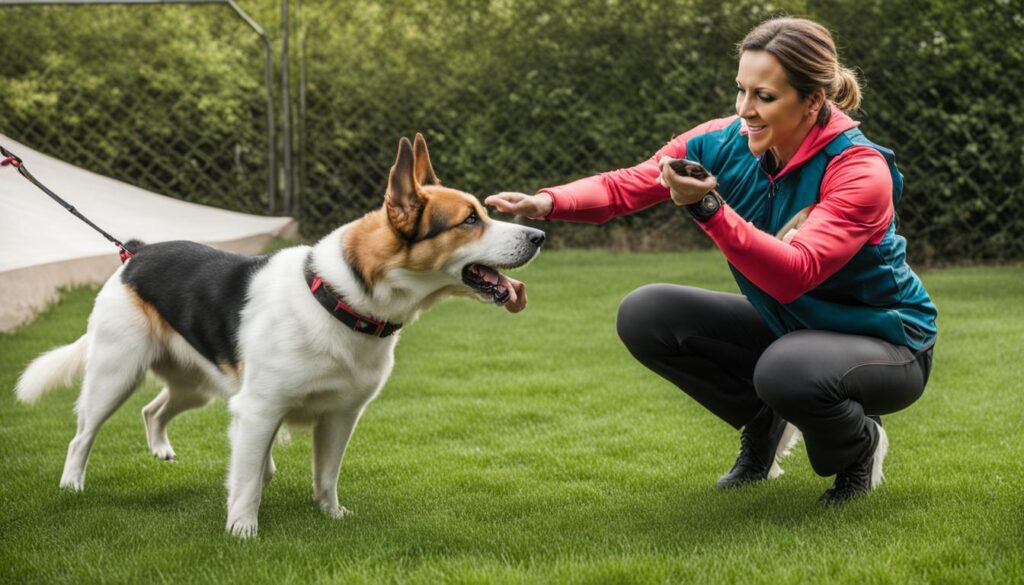Changing a dog’s behavior takes time and persistence. It is common for owners to give up after one unsuccessful attempt, but success often comes with calm persistence and repetition over weeks or months. Behaviors such as jumping on people or counter surfing can take time to change, and it may be difficult to achieve complete trustworthiness. It is important to communicate clearly with your dog, give them time to understand your expectations, and be persistent in your training approach.
Key Takeaways:
- Patience is crucial in dog training to allow for behavior change over time.
- Persistence and repetition are necessary for long-term success in training.
- Clear communication and realistic expectations are essential in training your dog.
- Building trust takes time and consistency in your training approach.
- Be patient with yourself and your dog, as training challenges will arise.
How to Cultivate Patience in Dog Training
To cultivate patience in dog training, it is important to build a patient training approach that focuses on consistency and positive reinforcement. Dogs learn best when new behaviors are introduced slowly and associated with positive experiences. For example, when getting your dog used to wearing a collar, start by introducing it gradually and reward them with high-value treats while they wear it. This helps them associate the collar with something positive, making it easier for them to accept it.
Overcoming frustration in dog training requires consistency and patience. When dealing with behaviors like jumping on people, it is essential to consistently ignore the behavior and provide attention only when the dog is calm. This teaches them that jumping does not result in attention, encouraging them to remain calm and seek alternative ways to interact with people.
Remember, patience is key in training. It may take time for your dog to fully understand and respond to your commands. Stay patient and consistent, and celebrate small successes along the way.
In addition to consistency and positive reinforcement, it is important to set clear goals and expectations in your training sessions. Break down complex behaviors into smaller steps and work on each step consistently. This allows you to track progress and make adjustments as needed. By setting clear goals and working towards them patiently, you can achieve long-term success in training your dog.

Building a Patient Training Approach
A patient training approach involves understanding that dogs learn at their own pace and may require time to fully grasp new behaviors. It emphasizes consistency and positive reinforcement, using rewards and praise to encourage desired behaviors. By cultivating patience and taking a calm and assertive approach, you can create a positive and supportive training environment for your dog.
Consistency and Patience in Training
Consistency is key in dog training. Using the same commands, rewards, and training techniques consistently helps dogs understand what is expected of them. Patience is crucial in overcoming challenges and setbacks that may arise during training. Remember that every dog is unique and may require different amounts of time to learn and adapt to new behaviors. Stay patient, keep practicing, and celebrate each milestone achieved in your dog’s training journey.
Strategies for Persistent Dog Training
When it comes to dog training, persistence is key. Every dog is unique, and some may present greater challenges than others. However, with the right strategies and a patient approach, you can achieve effective and long-lasting results. Here are some techniques for persistent dog training:
1. Consistency and Clear Communication
Consistency is crucial in dog training. Use the same commands and rewards consistently, and establish a regular training schedule. This helps your dog understand what is expected of them and reinforces their learning. Additionally, clear communication is essential. Use a firm yet gentle tone, and ensure your body language aligns with your commands. This clarity will help your dog better comprehend and respond to your training efforts.
2. Positive Reinforcement
Positive reinforcement is a powerful tool in dog training. Reward your dog with praise, treats, or playtime when they exhibit the desired behavior. This positive association reinforces their understanding and motivates them to repeat the behavior. Remember to reward your dog immediately after they perform the desired action to strengthen the association between the behavior and the reward.
3. Patience and Understanding for Difficult Dogs
Some dogs may be more challenging to train due to various factors such as fear, anxiety, or previous negative experiences. For these difficult dogs, it is crucial to be patient and understanding. Give them plenty of time to understand and respond to commands. Break down complex behaviors into smaller, manageable steps, and celebrate small successes along the way. By taking a patient and empathetic approach, you can build trust and overcome training obstacles.
| Techniques for Persistent Dog Training | Patient Training for Difficult Dogs | Strategies for Patient and Effective Training |
|---|---|---|
| Consistency and Clear Communication | Patience and Understanding | Positive Reinforcement |
| Regular training schedule | Celebrate small successes | Reward desired behavior |
| Same commands and rewards | Break down complex behaviors | Immediate reinforcement |
Remember that dog training requires time, effort, and a deep understanding of your furry companion. By employing these strategies and maintaining a patient and positive attitude, you will create a strong bond with your dog and achieve the training goals you desire. Keep practicing, stay persistent, and enjoy the journey of training your beloved canine companion.
The Role of Long-Term Commitment in Dog Training
When it comes to dog training, long-term commitment plays a crucial role in achieving success. Training a dog requires consistent effort and perseverance over an extended period of time. It’s not a quick fix or a one-time event, but rather an ongoing process that requires dedication and patience. By understanding the importance of long-term commitment, dog owners can encourage persistence and ensure their furry friends receive the training they need.
A key aspect of long-term commitment is recognizing that dog training is not a linear journey. There will be ups and downs, setbacks and breakthroughs. It’s important to stay motivated and remind yourself of the ultimate goal – to have a well-behaved and happy dog. Even when faced with challenges or slow progress, maintaining a positive attitude and staying committed to the training process is essential.
Encouraging persistence in dog owners is also crucial for long-term success. Providing support and resources to help owners stay engaged and motivated can make a significant difference. Online communities, training classes, and professional guidance can offer valuable insights and tips. Additionally, sharing success stories and celebrating milestones can inspire others to stay committed to their dog’s training journey.
| Key Strategies | Benefits |
|---|---|
| Consistent training schedule | Establishes routine and reinforces learning |
| Clear goals and expectations | Provides direction for training sessions |
| Positive reinforcement | Creates a positive association with desired behaviors |
| Continuous learning | Keeps training methods up-to-date and effective |
In conclusion, long-term commitment is essential in dog training. It requires dedication, perseverance, and a positive mindset. By staying committed to the training process and encouraging persistence in dog owners, we can create a harmonious relationship with our furry companions that is built on trust, respect, and effective communication.
Overcoming Training Challenges with Patience
Training a dog can be a rewarding but challenging experience. It’s important to approach these challenges with patience and persistence, as they are key to successful training. Dogs may encounter obstacles or exhibit behaviors that can test your patience, but with the right mindset and strategies, you can overcome these challenges and continue making progress in their training journey.
One common challenge in dog training is overcoming frustration. It’s natural to feel frustrated when your dog doesn’t seem to understand or respond to your commands. However, it’s crucial to remain calm and composed, as frustration can hinder the training process. Take a step back, assess the situation, and break down the behavior or skill you’re trying to teach into smaller, manageable steps. By taking it one step at a time and patiently working through each stage, you can help your dog understand and learn at their own pace.
Another important aspect of overcoming training challenges is identifying the root cause of the behavior. Understanding why your dog is exhibiting a certain behavior can help you address it effectively. For example, if your dog is barking excessively, it may be due to boredom, anxiety, or a lack of exercise. By addressing the underlying cause and providing alternative outlets for their energy, such as mental stimulation and physical exercise, you can work towards resolving the behavior over time.
Remember to celebrate small successes along the way. Training can be a journey with ups and downs, so it’s important to acknowledge and reward your dog’s progress, no matter how small. Positive reinforcement, such as treats, praise, and play, can motivate your dog and reinforce their good behavior. With patience, persistence, and a positive attitude, you can overcome training challenges and build a strong bond with your furry companion.

“Training can be a journey with ups and downs, so it’s important to acknowledge and reward your dog’s progress, no matter how small.”
Conclusion
Building a patient training approach is essential for successful dog training. It requires time, consistency, and understanding. By being patient with your dog and setting clear goals, you can create a positive training experience.
Strategies for patient and effective training include using positive reinforcement, maintaining clear communication, and staying calm and assertive. Remember to celebrate small successes along the way and stay committed to the long-term training process.
Developing a strong and positive relationship with your dog takes time and effort. With patience and persistence, you can overcome training challenges and build a bond that will last a lifetime. So, take a deep breath, stay committed, and enjoy the journey of training your furry friend!
FAQ
How long does it take to change a dog’s behavior?
Changing a dog’s behavior takes time and persistence. Success often comes with calm persistence and repetition over weeks or months.
What should I do if my dog jumps on people?
For behaviors like jumping on people, it is essential to consistently ignore the behavior and provide attention only when the dog is calm.
How can I cultivate patience in dog training?
To cultivate patience in dog training, it is important to introduce new behaviors slowly and associate them with positive experiences. Consistency and patience are key in overcoming frustration and building a patient training approach.
How do I overcome training challenges?
Training challenges can be overcome with patience and persistence. It is important to remain calm and patient when faced with challenges, identifying the root cause and breaking it down into smaller steps.
How long do I need to commit to dog training?
Long-term commitment is essential in dog training. Dogs require continued training and reinforcement throughout their lives.





